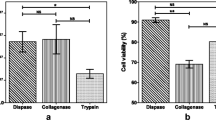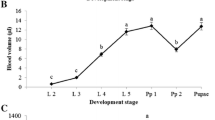Abstract.
Rhogocytes (pore cells) are specific molluscan cell types that are scattered throughout the connective tissues of diverse body parts. We have identified rhogocytes in large numbers in tissue taken from mantle, foot and midgut gland of the abalone Haliotis tuberculata (Vetigastropoda). Within cisternae of the endoplasmic reticulum, particles are visible that resemble, in shape and size, hemocyanin molecules, the respiratory protein of many molluscs. Immunohistochemical experiments using hemocyanin-specific antibodies demonstrated that these cells contain hemocyanin. In situ hybridization with a cDNA probe specific for Haliotis hemocyanin showed that hemocyanin-specific mRNA is present in rhogocytes, which confirmed that they are the site of hemocyanin biosynthesis in this gastropod. A possible path of hemocyanin release into the hemolymph is discussed. Also in the vetigastropod Megathura crenulata, many rhogocytes could be detected. However, they lacked hemocyanin molecules which, together with published data, indicates a seasonal expression of hemocyanin in this animal.
Similar content being viewed by others

Author information
Authors and Affiliations
Additional information
Electronic Publication
Rights and permissions
About this article
Cite this article
Albrecht, U., Keller, H., Gebauer, W. et al. Rhogocytes (pore cells) as the site of hemocyanin biosynthesis in the marine gastropod Haliotis tuberculata . Cell Tissue Res 304, 455–462 (2001). https://doi.org/10.1007/s004410100368
Received:
Accepted:
Issue Date:
DOI: https://doi.org/10.1007/s004410100368



